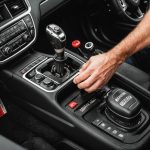Mastering Off-Road Adventures: Essential Tips for Perfecting Your Honda CRF1100L Africa Twin Suspension Setup
Understanding Your Honda Africa Twin
Before diving into the intricacies of suspension setup, it’s crucial to understand the capabilities and design of your Honda CRF1100L Africa Twin. This adventure bike is engineered to handle both on-road comfort and off-road agility, making it a versatile choice for riders who crave variety in their motorcycle adventures.
The Africa Twin features a robust suspension system, including a 45 mm inverted telescopic fork at the front and a Pro-Link® single shock at the rear. The front suspension offers 9.0 inches of travel, while the rear provides 8.7 inches, ensuring ample ground clearance and the ability to absorb rough terrain[1][4].
In parallel : Essential Guide to Choosing the Right Lubricant for Your Kawasaki ZX10R Ninja Swingarm
Assessing Your Riding Style
To perfect your suspension setup, you need to consider your riding style and the types of terrain you frequently encounter. Here are a few questions to ask yourself:
- On-Road vs. Off-Road: How often do you ride on paved roads versus off-road trails? This will help you decide whether to prioritize comfort or agility.
- Load and Weight: Are you often riding solo or with a passenger and luggage? The weight distribution affects the suspension’s performance.
- Terrain Difficulty: Do you ride on smooth trails or challenging, rocky terrain? This will influence the stiffness and damping settings.
Adjusting the Front Suspension
The front suspension of your Africa Twin is a critical component for both stability and control. Here are some tips for adjusting it:
Also to read : Essential Tools for Replacing Brake Discs on Your Suzuki Burgman 650: A Complete Guide
Preload Adjustment
- Preload is the initial compression of the spring. For lighter riders or those who prioritize comfort, reducing the preload can make the bike feel softer and more compliant. For heavier riders or those who need more stability, increasing the preload is advisable[4].
Damping Adjustment
- Damping controls the rate at which the fork compresses and rebounds. There are typically two types of damping adjustments: compression and rebound.
- Compression Damping: Adjust this to control how quickly the fork compresses. Higher compression damping is better for rough terrain, while lower settings are more comfortable on smooth roads.
- Rebound Damping: This controls how quickly the fork returns to its original position after compression. Proper rebound damping ensures the fork doesn’t bounce back too quickly, which can lead to instability.
Adjusting the Rear Suspension
The rear suspension, powered by the Pro-Link® system, is equally important for maintaining stability and control.
Preload Adjustment
- Similar to the front suspension, the rear preload needs to be adjusted based on the rider’s weight and the load carried. The Africa Twin Adventure Sports ES DCT model, for example, features electronic suspension adjustment, making this process more convenient[2].
Damping Adjustment
- The rear shock also has compression and rebound damping adjustments.
- Compression Damping: Adjust this to manage the shock’s compression rate. For off-road riding, you may want to increase compression damping to handle bumps and jumps.
- Rebound Damping: Ensure the rebound damping is set so that the rear end doesn’t bounce back too quickly, which can affect the bike’s stability.
Practical Tips for Adjustment
Here are some practical tips to keep in mind when adjusting your Africa Twin’s suspension:
- Start with Small Adjustments: Make incremental changes and test the bike after each adjustment to avoid over-correcting.
- Use the Right Tools: Ensure you have the correct tools for adjusting the suspension. For electronic suspension, follow the manufacturer’s guidelines.
- Test Ride: Always test ride your bike after making adjustments to feel how the changes affect the handling and comfort.
Detailed Adjustment Checklist
Here is a detailed checklist to help you adjust your Africa Twin’s suspension:
Front Suspension Adjustment Checklist
- Preload:
- Check the manufacturer’s recommended preload settings based on your weight.
- Adjust the preload using the spanner provided.
- Compression Damping:
- Start with the recommended setting and adjust in small increments.
- Test ride to feel the difference.
- Rebound Damping:
- Adjust rebound damping to ensure the fork returns smoothly without bouncing back too quickly.
Rear Suspension Adjustment Checklist
- Preload:
- Adjust the preload based on your weight and load.
- For electronic suspension, use the bike’s controls to adjust the preload.
- Compression Damping:
- Increase compression damping for off-road riding and decrease for on-road comfort.
- Test ride to ensure the setting is right for your riding style.
- Rebound Damping:
- Adjust rebound damping to ensure smooth return without excessive bouncing.
Comparison with Other Adventure Bikes
To put the Africa Twin’s suspension capabilities into perspective, here’s a comparison with another popular adventure bike, the BMW R 1250 GS:
| Feature | Honda CRF1100L Africa Twin | BMW R 1250 GS |
|---|---|---|
| Front Suspension Travel | 9.0 inches | 7.5 inches |
| Rear Suspension Travel | 8.7 inches | 7.9 inches |
| Ground Clearance | 250 mm | 220 mm |
| Suspension Type | 45 mm inverted telescopic fork, Pro-Link® single shock | BMW Telelever front, Paralever rear |
| Electronic Suspension | Available on Adventure Sports ES DCT | Available on some models |
This comparison highlights the Africa Twin’s superior ground clearance and suspension travel, making it more adept at handling challenging off-road terrain[4].
Real-World Examples and Anecdotes
Vanessa Ruck, a seasoned motorcycle adventurer, shared her experience with adjusting the suspension on her Africa Twin:
“When I first got my Africa Twin, I found it a bit too stiff for my liking. After consulting the manual and making some adjustments to the preload and damping, the bike transformed. It was like riding a different motorcycle. The key is to take your time and make small adjustments, testing the bike after each change.” and Final Tips
Mastering the suspension setup on your Honda CRF1100L Africa Twin is a process that requires patience, understanding, and practice. Here are some final tips to keep in mind:
- Read the Manual: Always refer to the manufacturer’s manual for specific adjustment guidelines.
- Seek Professional Help: If you’re unsure, consult a professional mechanic or a suspension specialist.
- Keep it Consistent: Ensure that both front and rear suspensions are adjusted consistently to maintain balance and stability.
- Test and Adjust: Continuously test ride your bike and make adjustments as needed to find the perfect setup for your riding style.
By following these tips and understanding the intricacies of your Africa Twin’s suspension, you’ll be well on your way to perfecting your off-road adventures and enjoying a more comfortable and controlled ride, whether you’re navigating the trails or cruising down the highway.











